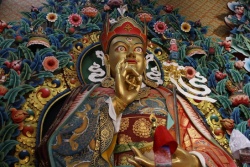Nyingma Institutions and Spiritual Heads
Unlike the Kagyu, Sakya and Gelug lineages, the Nyingma were for a long time based less on centralised institutional structures than on individual lines of transmission. Apart from Samye, no major monasteries were built until the founding of Kathok in 1159, and it wasn't until the 15th century that Nyingma teachers really began to build the great Nyingma monastic centres. The most important monasteries are known as the Six Great Seats or the Six Great Mothers of the Nyingma lineage: Kathok (above), Mindrolling, founded in 1676; Dorje Drak, founded in 1632; Dzogchen, founded in 1685; Shechen, founded in 1735; and Palyul, founded in 1665.
After many of these were destroyed during the changes of the mid-twentieth century, they have now been either fully or partially rebuilt. At the same time, the heads and masters of these monasteries have also established their seats outside of Tibet, in India, Nepal, and Bhutan.
Due to its lack of institutionalisation and decentralised character, the Nyingma, unlike the other lineages, remained without an overall spiritual head until around the 1960s. In order to find cohesion and unity within exile and to ensure the preservation of their traditions, it became especially important for all lineages to organise themselves around their leaders. This was particularly the case for the Nyingmapas who had so far been without such a representative. For this reason Kyabje Dudjom Rinpoche (c. 1904–1987), was the first Nyingma teacher to be accorded the title of Supreme Head of the Nyingma school, a position which he held from the 1960s until his death. After Dudjom Rinpoche, the leaders of the Nyingma school have been as follows: Dilgo Khyentse Rinpoche (c. 1910–1991), served from 1987 until his death; Penor (Pema Norbu) Rinpoche (1932–2009), who served from 1991 until retirement in 2003; Mindrolling Trichen Rinpoche (c. 1930–2008), who served from 2003 until his death; Trulshik Rinpoche (1923–2011), who served from 2010 until his death in 2011 (he was selected after Chatral Rinpoche declined the position; and Taklung Tsetrul Rinpoche (b.1926) accepted this position on 22 March, 2012.
